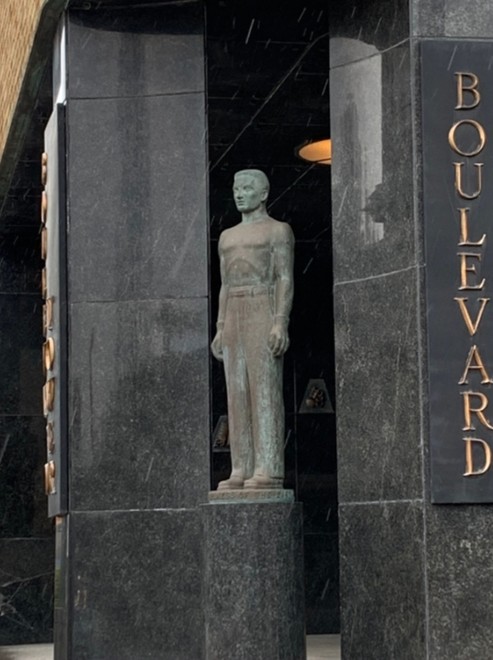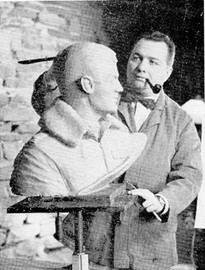From the Fullness of the Earth (United Carbon Man)
Introduction
Text-to-speech Audio
Images
From the Fullness of the Earth.

Robert Erle Martens working on a bust of Major Charles E. Yeager.

Backstory and Context
Text-to-speech Audio
From the Fullness of the Earth sculptor Robert Erle Martens was born in 1919 in Illinois, though his family soon moved to Charleston. The young man attended Cranbrook Academy of Art, where he studied architectural design, before continuing his education with the Department of Agriculture at Yale University. Martens then served in World War II. During the war, the budding artist was encouraged to create sculpture by Lieutenant J.F. Saarade of the Free French Forces. Upon returning to Charleston, Martens commenced work with his father's architectural firm, Martens and Son, Architects. The younger Martens led the design of the United Carbon Building — built for Oscar Nelson's carbon Black production company — and created the sculpture that sits at its base.
From the Fullness of the Earth depicts an emblematic and idealized worker. The male figure stands resolutely and gazes straight ahead, reminiscent of works from Antiquity. The man wears simple shoes and trousers, with no shirt. Martens said that the figure, "represents a workman, not definitely a laborer, nor a chemist, nor an office man."1 The figure is a paragon, referring not to any particular person or group of people, but to all humanity. It represents the way we take resources from the earth and refine them into industrial products. The name From the Fullness of the Earth is possibly a reference to the biblical passage Psalm 24:1, which reads "The earth is the Lord's, and the fullness thereof." This echoes the sculpture's themes of creation, while carrying a moralizing message that humanity ultimately belongs to God.
Sources
1. Agsten Jr, Carl F. United Carbon Building, National Register of Historic Places. June 8th 1994. Accessed December 11th 2020. http://www.wvculture.org/shpo/nr/pdf/kanawha/94000720.pdf.
Psalm 24:1 Parallel Verses, Bibleref. Accessed December 11th 2020. https://www.bibleref.com/Psalms/24/Psalm-24-1.html.
Robert E. Martens – United Carbon Man and Other Works 1938-1953, Justamodernguy. September 14th 2009. Accessed December 11th 2020. http://justamodernguy.com/?p=251.
Robert Erle Martens (1919 - aft. 1995), Wikitree. August 16th 2018. Accessed December 11th 2020. https://www.wikitree.com/wiki/Martens-1020.
West Virginia Modernism – Robert E. Martens – Part 1, Justamodernguy. October 29th 2007. Accessed December 11th 2020. http://justamodernguy.com/?p=9.
West Virginia Modernism – Robert E. Martens – Part 2, Justamodernguy. October 30th 2007. Accessed December 11th 2020. http://justamodernguy.com/?p=10.
Office of Public Art, Charleston WV. Accessed December 11, 2020. https://gisweb.cityofcharleston.org/storymaps/arttour/#.
Justamodernguy. Accessed December 11, 2020. http://justamodernguy.com/?p=9.
